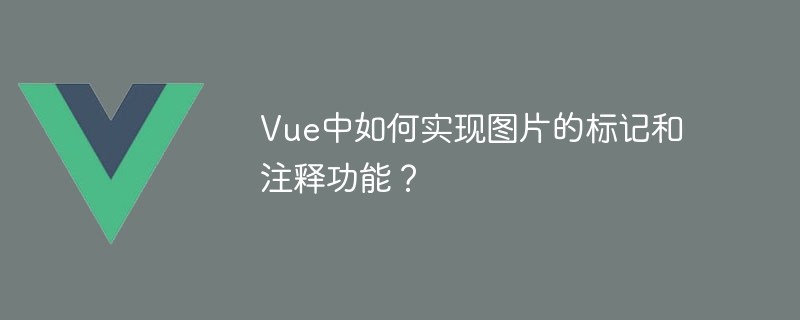Vue で画像のタグ付けと注釈機能を実装するにはどうすればよいですか?

Vue で画像のタグ付けと注釈機能を実装するにはどうすればよいですか?
Web ページやアプリケーションを開発する場合、多くの場合、画像の内容をより適切に表示および説明するために、画像にマークを付けたり注釈を付けたりする必要があります。人気のあるフロントエンド フレームワークとして、Vue は画像のタグ付けや注釈機能を簡単に実装できる豊富なツールとコンポーネントを提供します。この記事では、Vue を使用して画像のタグ付けと注釈機能を実装する方法を紹介し、関連するコード例を示します。
- 準備
始める前に、いくつかの準備をする必要があります。まず、Vue プロジェクトを作成し、関連する依存関係をインストールする必要があります。次のコマンドを使用して、新しい Vue プロジェクトを作成できます。
1 |
|
次に、プロンプトに従って、インストールに対応する構成と依存関係を選択します。
- 画像コンポーネントの追加
Vue プロジェクトでは、<img src="/static/imghw/default1.png" data-src="imageSrc" class="lazy" alt="Vue で画像のタグ付けと注釈機能を実装するにはどうすればよいですか?" >タグを使用して画像を表示できます。後続の操作を容易にするために、画像コンポーネントImageAnnotationをカプセル化できます。コードは次のとおりです。
1 2 3 4 5 6 7 8 9 10 11 12 13 14 15 16 17 18 19 20 21 22 23 24 25 26 27 28 29 30 31 32 33 34 35 36 37 38 39 40 41 42 43 44 45 46 47 48 49 50 51 52 53 54 55 56 57 58 59 60 61 62 63 64 65 66 |
|
上記のコードでは、<img src="/static/imghw/default1.png" data-src="imageSrc" class="lazy" > を使用します。 ;</code alt="Vue で画像のタグ付けと注釈機能を実装するにはどうすればよいですか?" > ラベルには画像が表示され、画像をクリックすると <code>handleClick メソッドがトリガーされます。 handleClick メソッドでは、event.offsetX および event.offsetY を通じて現在のクリックの座標を取得し、$emit## を使用します。 # 親コンポーネントに座標情報を渡すメソッド。
v-for ディレクティブを使用して注釈をレンダリングし、@click イベントを通じて注釈のクリック操作を監視します。注釈をクリックすると、handleAnnotationClick メソッドがトリガーされ、注釈情報が親コンポーネントに渡されます。
- 画像コンポーネントを使用する
- 画像コンポーネント
ImageAnnotationをアプリケーションで使用し、画像アドレスと注釈情報をpropsを介して渡します。
1 2 3 4 5 6 7 8 9 10 11 12 13 14 15 16 17 18 19 20 21 22 23 24 25 26 27 28 29 30 31 32 33 34 35 36 37 38 |
|
app という名前の Vue インスタンスを作成し、テンプレート内の ImageAnnotation コンポーネントを使用しました。 add-annotation および edit-annotation イベントをリッスンしながら、props を介して画像アドレスと注釈配列をコンポーネントに渡し、対応するイベント処理メソッドのデータ。
この記事では、Vue で画像のタグ付けと注釈機能を実装する方法を紹介します。画像コンポーネントをカプセル化し、コンポーネント内のクリック イベントと注釈表示を処理し、
props と $emit を通じてデータを渡して更新します。この方法はシンプルで理解しやすく、実際のニーズに応じて拡張およびカスタマイズすることもできます。この記事が、Vue の画像タグ付けと注釈機能の理解と実践に役立つことを願っています。
以上がVue で画像のタグ付けと注釈機能を実装するにはどうすればよいですか?の詳細内容です。詳細については、PHP 中国語 Web サイトの他の関連記事を参照してください。

ホットAIツール

Undresser.AI Undress
リアルなヌード写真を作成する AI 搭載アプリ

AI Clothes Remover
写真から衣服を削除するオンライン AI ツール。

Undress AI Tool
脱衣画像を無料で

Clothoff.io
AI衣類リムーバー

Video Face Swap
完全無料の AI 顔交換ツールを使用して、あらゆるビデオの顔を簡単に交換できます。

人気の記事

ホットツール

メモ帳++7.3.1
使いやすく無料のコードエディター

SublimeText3 中国語版
中国語版、とても使いやすい

ゼンドスタジオ 13.0.1
強力な PHP 統合開発環境

ドリームウィーバー CS6
ビジュアル Web 開発ツール

SublimeText3 Mac版
神レベルのコード編集ソフト(SublimeText3)

ホットトピック
 1669
1669
 14
14
 1428
1428
 52
52
 1329
1329
 25
25
 1273
1273
 29
29
 1256
1256
 24
24
 小紅書で公開するときに写真が自動的に保存される問題を解決するにはどうすればよいですか?投稿時に自動保存された画像はどこにありますか?
Mar 22, 2024 am 08:06 AM
小紅書で公開するときに写真が自動的に保存される問題を解決するにはどうすればよいですか?投稿時に自動保存された画像はどこにありますか?
Mar 22, 2024 am 08:06 AM
ソーシャルメディアの継続的な発展に伴い、Xiaohongshu はますます多くの若者が自分たちの生活を共有し、美しいものを発見するためのプラットフォームとなっています。多くのユーザーは、画像を投稿する際の自動保存の問題に悩まされています。では、この問題をどうやって解決すればよいでしょうか? 1.小紅書で公開するときに写真が自動的に保存される問題を解決するにはどうすればよいですか? 1. キャッシュをクリアする まず、Xiaohongshu のキャッシュ データをクリアしてみます。手順は次のとおりです: (1) 小紅書を開いて右下隅の「マイ」ボタンをクリックします。 (2) 個人センター ページで「設定」を見つけてクリックします。 (3) 下にスクロールして「」を見つけます。 「キャッシュをクリア」オプションを選択し、「OK」をクリックします。キャッシュをクリアした後、Xiaohongshu を再起動し、写真を投稿して、自動保存の問題が解決されるかどうかを確認します。 2. 小紅書バージョンを更新して、小紅書が正しく動作することを確認します。
 TikTokのコメントに写真を投稿するにはどうすればよいですか?コメント欄の写真への入り口はどこですか?
Mar 21, 2024 pm 09:12 PM
TikTokのコメントに写真を投稿するにはどうすればよいですか?コメント欄の写真への入り口はどこですか?
Mar 21, 2024 pm 09:12 PM
Douyin のショートビデオの人気により、コメント エリアでのユーザーのやり取りがより多彩になりました。ユーザーの中には、自分の意見や感情をよりよく表現するために、コメントで画像を共有したいと考えている人もいます。では、TikTokのコメントに写真を投稿するにはどうすればよいでしょうか?この記事では、この質問に詳しく答え、関連するヒントと注意事項をいくつか紹介します。 1.Douyinのコメントに写真を投稿するにはどうすればよいですか? 1. Douyinを開く: まず、Douyin APPを開いてアカウントにログインする必要があります。 2. コメントエリアを見つける:短いビデオを閲覧または投稿するときに、コメントしたい場所を見つけて「コメント」ボタンをクリックします。 3. コメントの内容を入力します: コメント領域にコメントの内容を入力します。 4. 写真の送信を選択します。コメント内容を入力するインターフェースに「写真」ボタンまたは「+」ボタンが表示されます。
 PPT画像を1枚ずつ表示させる方法
Mar 25, 2024 pm 04:00 PM
PPT画像を1枚ずつ表示させる方法
Mar 25, 2024 pm 04:00 PM
PowerPoint では、画像を 1 枚ずつ表示するのが一般的な手法ですが、これはアニメーション効果を設定することで実現できます。このガイドでは、基本的なセットアップ、画像の挿入、アニメーションの追加、アニメーションの順序とタイミングの調整など、この手法を実装する手順について詳しく説明します。さらに、トリガーの使用、アニメーションの速度と順序の調整、アニメーション効果のプレビューなど、高度な設定と調整が提供されます。これらの手順とヒントに従うことで、ユーザーは PowerPoint で次々に表示される画像を簡単に設定できるため、プレゼンテーションの視覚的な効果が高まり、聴衆の注意を引くことができます。
 掃海艇をマークするにはどうすればよいですか? - マインスイーパの難易度を変更するにはどうすればよいですか?
Mar 18, 2024 pm 06:34 PM
掃海艇をマークするにはどうすればよいですか? - マインスイーパの難易度を変更するにはどうすればよいですか?
Mar 18, 2024 pm 06:34 PM
掃海艇をマークするにはどうすればよいですか?まず、マインスイーパでのマーキング方法に慣れる必要があります。通常、マインスイーパ ゲームには、フラグ マークとクエスチョン マーク マークの 2 つの一般的なマーク方法があります。フラグ マークは、ブロック内に地雷が存在することを示すために使用され、確定的なマークである一方、疑問符マークは、ブロック内に地雷が存在する可能性があるが、確定的ではないことを示します。これら 2 つのマーキング方法はゲームにおいて重要な役割を果たし、プレイヤーがどのブロックに地雷が含まれている可能性があるかを推測して、効果的に次のステップに進むのに役立ちます。これらのマーキング方法を上手に使用すると、掃海艇ゲームでのプレイヤーの成功率が向上し、地雷を踏むリスクを軽減できます。したがって、掃海艇ゲームをプレイする際に、旗マークと疑問符マークをマスターしていれば、あるマス目に地雷があるかどうか分からないときに、疑問符マークを使ってマークすることができる。
 iPhone で写真をより鮮明にする 6 つの方法
Mar 04, 2024 pm 06:25 PM
iPhone で写真をより鮮明にする 6 つの方法
Mar 04, 2024 pm 06:25 PM
Apple の最近の iPhone は、鮮明なディテール、彩度、明るさで思い出を捉えます。ただし、場合によっては、画像が鮮明に見えなくなる問題が発生することがあります。 iPhone カメラのオートフォーカスは大きく進歩し、写真をすばやく撮影できるようになりましたが、状況によってはカメラが誤って間違った被写体に焦点を合わせ、不要な領域で写真がぼやけてしまうことがあります。 iPhone 上の写真の焦点が合っていない場合、または全体的に鮮明さが欠けている場合は、次の投稿を参照して写真を鮮明にすることができます。 iPhone で写真を鮮明にする方法 [6 つの方法] ネイティブの写真アプリを使用して写真をクリーンアップしてみることができます。さらに多くの機能やオプションが必要な場合
 百度地図で複数の場所をマークする方法 複数の場所をマークする方法
Mar 15, 2024 pm 04:28 PM
百度地図で複数の場所をマークする方法 複数の場所をマークする方法
Mar 15, 2024 pm 04:28 PM
上記には、特に複数の場所をマークできる地図の場合に多くの関数があります。いくつかの場所がわかったら、さまざまな側面を提供できるように、必ずいくつかの句読点関数を使用します。マークする関数の中には、距離を生成するものもあります。もちろん、上記の場所の名前や詳細情報も表示されますが、多くのネチズンは上記の内容に精通していない可能性があります。コンテンツ情報は表示されません。非常に明確なので、皆さんがさまざまな側面でより良い選択をできるように、今日は編集者がさまざまな側面でいくつかの選択肢を提供しますので、アイデアに興味のある友人、あなたも興味がある場合は、試しに来てください。標準
 Web ページ上の画像を読み込めない場合はどうすればよいですか? 6つのソリューション
Mar 15, 2024 am 10:30 AM
Web ページ上の画像を読み込めない場合はどうすればよいですか? 6つのソリューション
Mar 15, 2024 am 10:30 AM
一部のネチズンは、ブラウザの Web ページを開いたときに、Web ページ上の画像が長時間読み込めないことに気づきました。何が起こったのでしょうか?ネットワークは正常であることを確認しましたが、どこに問題があるのでしょうか?以下のエディタでは、Web ページの画像が読み込めない問題に対する 6 つの解決策を紹介します。 Web ページの画像を読み込めない: 1. インターネット速度の問題 Web ページに画像が表示されません。これは、コンピュータのインターネット速度が比較的遅く、コンピュータ上で開いているソフトウェアが多いためと考えられます。また、アクセスする画像が比較的大きいため、読み込みタイムアウトが原因である可能性があります。その結果、画像が表示されません。ネットワーク速度をより多く消費するソフトウェアをオフにすることができます。タスク マネージャーに移動して確認できます。 2. 訪問者が多すぎる Web ページに写真が表示されない場合は、訪問した Web ページが同時に訪問されたことが原因である可能性があります。
 PyCharm ショートカット キーを便利に使用して複数行コメントを実装する
Jan 27, 2024 am 08:02 AM
PyCharm ショートカット キーを便利に使用して複数行コメントを実装する
Jan 27, 2024 am 08:02 AM
PyCharm 複数行コメント ショートカット キー: コード コメントをより便利にし、特定のコード サンプルを必要とする日常のプログラミング作業において、コード コメントは非常に重要な部分です。コードの読みやすさと保守性が向上するだけでなく、他の開発者がコードの意図や設計アイデアを理解するのにも役立ちます。ただし、コード コメントを手動で追加するのは、多くの場合、時間がかかり、退屈な作業です。コードのコメントをより効率的にするために、PyCharm には複数行のコメント用のショートカット キーが用意されています。 PyCharm では、Ctrl+/ を使用できます。




